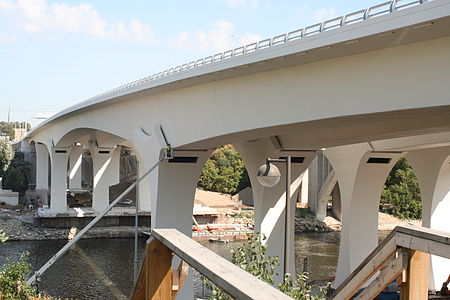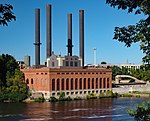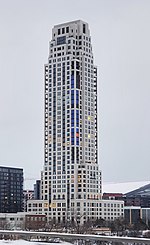I-35W Saint Anthony Falls Bridge
2007 in the United StatesBox girder bridges in the United StatesBridges completed in 2008Bridges in MinneapolisBridges on the Interstate Highway System ... and 6 more
Bridges over the Mississippi RiverConcrete bridges in the United StatesInterstate 35Road bridges in MinnesotaUse American English from September 2019Use mdy dates from September 2019

The I-35W Saint Anthony Falls Bridge crosses the Mississippi River one-half mile (875 m) downstream from the Saint Anthony Falls in Minneapolis, Minnesota in the U.S., carrying north–south traffic on Interstate Highway 35W. The ten-lane bridge replaced the I-35W Mississippi River bridge, which collapsed on August 1, 2007. It was planned and is maintained by the Minnesota Department of Transportation (Mn/DOT). The planning, design, and construction processes were completed more quickly than normal because Interstate 35W is a critical artery for commuters and truck freight. The bridge opened September 18, 2008, well ahead of the original goal of December 24.
Excerpt from the Wikipedia article I-35W Saint Anthony Falls Bridge (License: CC BY-SA 3.0, Authors, Images).I-35W Saint Anthony Falls Bridge
West River Parkway Trail, Minneapolis
Geographical coordinates (GPS) Address External links Nearby Places Show on map
Geographical coordinates (GPS)
| Latitude | Longitude |
|---|---|
| N 44.978888888889 ° | E -93.245 ° |
Address
I-35W Saint Anthony Falls Bridge
West River Parkway Trail
55454 Minneapolis
Minnesota, United States
Open on Google Maps











